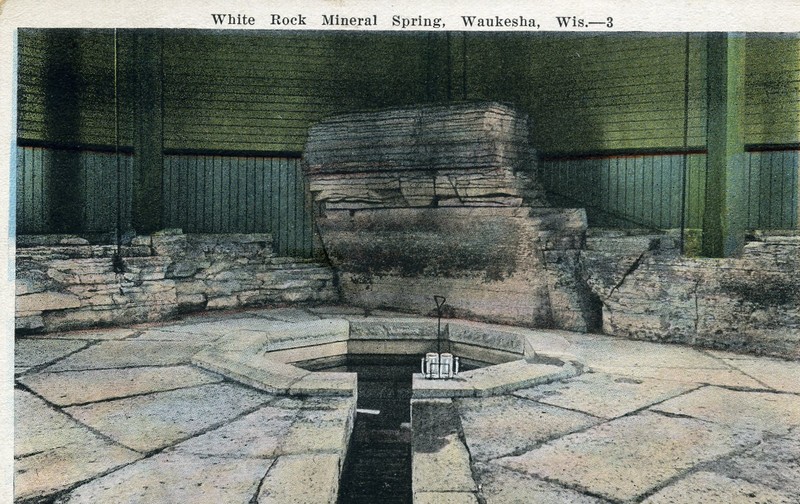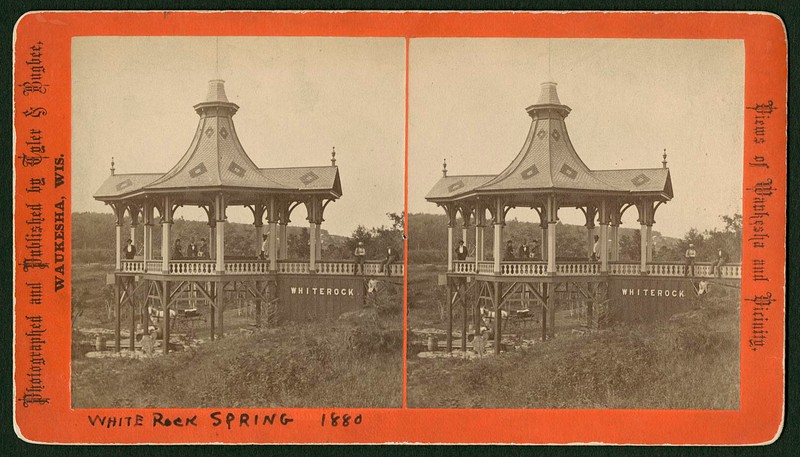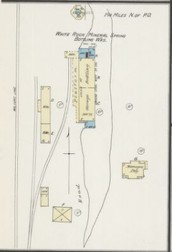This entry includes a walking tour! Take the tour.
Introduction
Text-to-speech Audio
White Rock Spring Company became Waukesha's most famous and well known spring, and is the only active brand that survives to the present day.
Founded in 1871, White Rock employed agressive print advertising campaigns, becoming a major national and global brand in the 20th century. The trademark image "Psyche at Nature's Mirror" became one of the most recognizable trademarks in the world.
In 1970, White Rock moved all of its operations from Waukesha to New York, where the company and brand still lives on today. The owners of the remaining White Rock buildings in Waukesha did not maintain the site, and had it demolished in 1996.
Images

White Rock Spring 1880 Stereo View

White Rock Complex 1890 Sanborn Map Section

Backstory and Context
Text-to-speech Audio
One of the longest surviving springs sites in the city, White Rock spring was located along the northern turn of the Fox River in Waukesha, just beyond the northern most end of Frame Park.
Hiram Colver, a Waukesha lawyer, purchased the property in 1873 and began advertising the spring that year. In 1874, he built a pavilion over the spring site to protect the water from contaminants. This structure was destroyed by a tornado in 1876, but quickly replaced with a more elaborate spring house. Colver continued to improve the grounds around the spring, though left much of it in a natural state. Starting in 1879, a steamboat named the White Rock Steamer ran along the Fox River taking passengers from the downtown area up to the park in which the spring was located.
In 1882, the business was purchased by Chicago Druggists Edwin O. Gale and William F. Blocki. They built a new bottling plant in 1883 to capitalize on growth through national distribution. The plant was placed along the existing railroad line. A bridge was constructed over the Fox River near the plant and new carriage drives were laid, making it easier to reach the park.
Gale and Blocki sold part of their spring to Gales brother-in-law Charles E. Welch, in 1887. Welch built a beautiful home adjacent to the bottling plant, and moved his exuberant family to Waukesha. He increased production, and adding onto the bottling facilities in 1900. It was under his ownership that the company also acquired it's most recognizable attribute: the Psyche trademark. The company acquired right to Paul Thurman's painting of "Psyche at Nature's Mirror" at the World's Columbian Exposition in Chicago in 1893. The words "White Rock" were added to the rock upon which the winged-nymph knelt. Soon the sales of White Rock Water took off. Another innovation for which Welch was responsible for was the carbonation of the water and advertising it as a table water rather than a medical water. Sales of the water grew tremendously and in May 1906 Welch sold the company for $1,300,000.
The National Water Company, a division of Wilson Whisky Distilling Company of Baltimore, ran the company for the next few years. Because of its extensive distribution system, White Rock was available worldwide and received numerous awards and honors from international expositions. In 1909, another addition was made to the bottling plant. This addition was remarkable and unique; built using reinforced concrete and modeled after an Egyptian temple. The Wilson Distributing Company ended its lease with White Rock in 1913, and the company was strong enough to stand on its own and eventually was listed on the New York Stock Exchange.
White Rock in the 20th century capitalized on print advertising campaigns, with campaign runs in numerous magazines including Harper's Weekly and LIFE. There was also a large electric advertising sign in Times Square in New York City as early as 1911. White Rock Waukesha water was famously served at the coronation of King Edward VII, and President William McKinley's 1897 Inauguration luncheon. Charles Lindbergh even drank White Rock water before his famous Spirit of St. Louis flight. Although Psyche was a fixture of their campaigns, White Rock is also notable for using a modern image of Santa Claus before Coca Cola did.
Business continued to flourish in the 1920s and 30s. During the following decades, business held steady with the competition of franchised drinks. In the 1950's, however, White Rock's share of the market declined. An attempt at franchising met with mixed results. In 1970, the company ceased operations in Waukesha. The White Rock Corporation continues however, today based in White Plains, New York. As of 2021, the company celebrates its 150th anniversary.
The Waukesha buildings remained intact for the next 20 years, although they were poorly maintained. In 1993, they were nominated as local landmarks by the Landmarks Commission. The owners of the complex petitioned for demolition of the 1909 addition to the plant, and after a series of public hearings the Common Council overrode the decision of the Landmarks Commission and allowed the demolition to take place.
In 1996, the owners asked for the rescission of the local landmark designation, and this was denied. They then applied for a demolition permit for each of the remaining structures. The designation was eventually removed and the badly deteriorated spring house and buildings were demolished.
Sources
Spring City's Past, Waukesha Landmarks Commission, January 2002.
Schoenknecht, John Martin. Great Waukesha Springs Era 1868-1918. Edition 1. Waukesha, WI. John M. Schoenknecht, 2003.
www.whiterockbeverages.com/our-history.
WI Historical Society Archieves
1890 Sanborn Map of Waukesha
